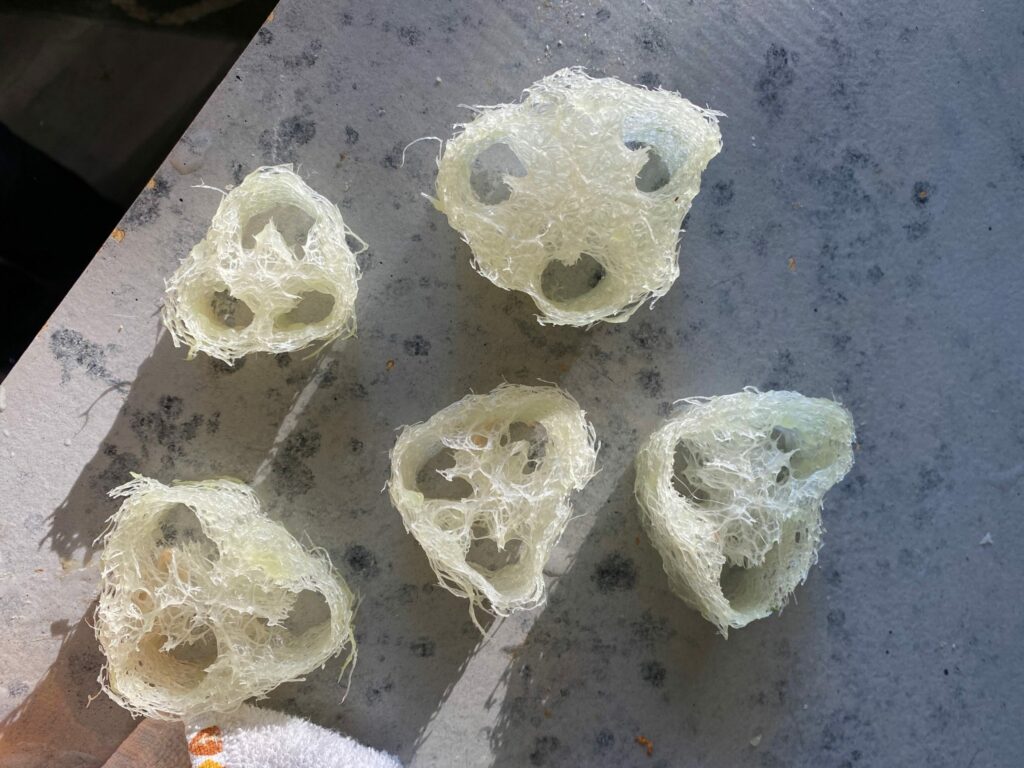I am about to embark on my third year of growing luffa gourds. I learned many things in my first two years working with these strange plants! I hope you can learn from my mishaps and mistakes along the way.
This post may contain affiliate links, meaning we may earn a commission for any purchases made through our links.
Start your luffa plants early.
Luffa gourds are SLOW my friends. If you’re reading this in late May thinking you’re going to pop some luffa in right now, I’d recommend you wait until next year. They take about 150 days (or more) to mature, so they really need to get in the ground ASAP if you have any hope of harvesting more than a few before it starts to freeze.
I’ve tried to start them indoors but they don’t seem to transplant very well either. Here in Nebraska, direct sowing ASAP in May is the way to go.
Be patient.
As I said – luffa gourds are slow. The vines go ballistic once it warms up in June, but all that growth is predominantly leaves. We learned last year that giving the plants a good trim promoted the growth of more gourds, so we’re going to emphasize that a little earlier on this year.
Water your luffa regularly.
Like just about everything else, luffa like a consistent watering schedule. Don’t overdo it so that the soil is wet all the time, but don’t let it get too dry either. Luffa looooove the hot midsummer sun but appreciate a good drink in the morning on those extra toasty days.
Leave them on the vine as long as possible.
A luffa is ready to be harvested when it is a dry brown color, and the seeds can be heard rattling around inside. Most of ours don’t get to this point while still on the vine because they take too long for our Nebraska growing season. However, contrary to what the rest of the internet has told me, they can be picked when green and left to dry off the vine.
This is unpopular, but the alternative is frozen squishy luffa gourd, so I accept my fate of having to pick them green and let them dry on the counter for a few weeks.
They get covered in ants, and that’s totally fine.
Fun fact I learned about luffa gourds last summer: They’re covered in something called extrafloral nectaries that attract ants.
So if you notice your luffa absolutely loaded with ants – don’t worry about it. They’re completely harmless to you and beneficial to your plants.
It’s also fine that the flowers fall off.
Male luffa flowers seem to be drama kings who don’t stick around long. I haven’t found a great reason as to why this is, but it seems generally normal that the male flowers fall off easily, even after just a day or two after appearing.
As long as the female flowers are being pollinated, I wouldn’t worry about it if the male flowers fall off.
Once luffa gourds start growing, they grow FAST.
I said luffa gourds are slow, right?
Well, that’s only half true. They take for-ever-loving-ever to get going, but once they do they are going. I didn’t trellis ours at all our first year gardening because I’m a moron. Then, in 2022, I trellised them with a sort of zig-zag bean trellis-type contraption.
THIS YEAR THEY’RE GOING ON THE TUNNELS BECAUSE THEY’RE HUGE.
Don’t worry if you fail.
As with all things in the garden, growing luffa is an experiment. Your region, soil, watering schedule, seed variety – all of these things will impact how well your luffa gourds grow.
Don’t be surprised if it takes a few seasons to figure out what works for you and your growing conditions.
If all else fails, you can always buy sustainable luffa sponges grown by someone else if growing them yourself just winds up not being your jam. There are plenty of online options, and I know Exist Green here in Omaha has a bunch of different types.

